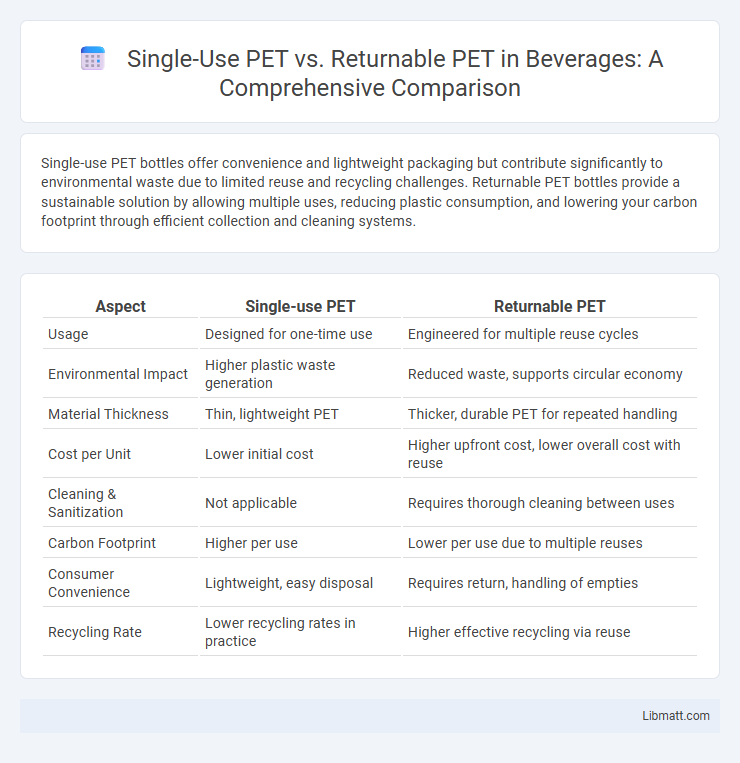Single-use PET bottles offer convenience and lightweight packaging but contribute significantly to environmental waste due to limited reuse and recycling challenges. Returnable PET bottles provide a sustainable solution by allowing multiple uses, reducing plastic consumption, and lowering your carbon footprint through efficient collection and cleaning systems.
Table of Comparison
| Aspect | Single-use PET | Returnable PET |
|---|---|---|
| Usage | Designed for one-time use | Engineered for multiple reuse cycles |
| Environmental Impact | Higher plastic waste generation | Reduced waste, supports circular economy |
| Material Thickness | Thin, lightweight PET | Thicker, durable PET for repeated handling |
| Cost per Unit | Lower initial cost | Higher upfront cost, lower overall cost with reuse |
| Cleaning & Sanitization | Not applicable | Requires thorough cleaning between uses |
| Carbon Footprint | Higher per use | Lower per use due to multiple reuses |
| Consumer Convenience | Lightweight, easy disposal | Requires return, handling of empties |
| Recycling Rate | Lower recycling rates in practice | Higher effective recycling via reuse |
Introduction to Single-use and Returnable PET
Single-use PET bottles are designed for one-time usage and are commonly used in beverages and packaging due to their lightweight and convenience. Returnable PET bottles offer a sustainable alternative by being durable and reusable, significantly reducing plastic waste through multiple cycles of collection, cleaning, and refilling. The choice between single-use and returnable PET impacts environmental footprints, cost efficiency, and recycling infrastructure requirements.
Environmental Impact Comparison
Single-use PET bottles contribute significantly to plastic pollution due to their low recycling rates and high energy consumption during production. Returnable PET containers reduce environmental impact by enabling multiple reuse cycles, lowering raw material demand, and decreasing greenhouse gas emissions by up to 70% compared to single-use PET. Lifecycle assessments highlight that shifting to returnable PET systems can dramatically reduce landfill waste and resource depletion, supporting sustainable packaging initiatives.
Economic Considerations and Cost Analysis
Single-use PET bottles often incur higher long-term costs due to continuous production, disposal fees, and environmental taxes, while returnable PET bottles reduce expenses through reuse and lower raw material consumption. Investing in returnable PET systems can yield substantial savings by minimizing waste management costs and promoting circular economy practices. Your choice between single-use and returnable PET containers directly impacts operational efficiency and overall sustainability budgeting.
Manufacturing and Material Differences
Single-use PET bottles are manufactured using lightweight, thin plastic designed for one-time use, emphasizing cost-efficiency and low material consumption per unit. Returnable PET bottles utilize thicker, more durable plastic to withstand repeated cleaning and refilling cycles, resulting in higher initial material input but extended lifecycle utility. Manufacturing processes for returnable PET involve enhanced quality control and sterilization compatibility, ensuring structural integrity over multiple uses, while single-use PET production prioritizes speed and volume.
Collection and Recycling Systems
Single-use PET bottles are collected through curbside recycling programs and require effective sorting systems to prevent contamination and ensure high recycling rates. Returnable PET bottles rely on deposit return systems (DRS), which incentivize consumers to return bottles, achieving recovery rates often exceeding 90%. Optimizing Your collection and recycling processes involves adapting infrastructure to the specific PET type, promoting deposit schemes for returnable PET to maximize reuse and reduce environmental impact.
Consumer Convenience and Behavior
Single-use PET bottles offer high consumer convenience due to their lightweight design and easy disposal, catering to on-the-go lifestyles and immediate use. Returnable PET bottles require consumers to engage in recycling or return processes, which may reduce convenience but promote environmental responsibility and reuse behavior. Consumer behavior tends to favor single-use PET for simplicity, while growing awareness of sustainability increasingly motivates the adoption of returnable PET options.
Lifecycle Assessment of PET Bottles
Lifecycle assessment of single-use PET bottles reveals higher environmental impacts due to frequent production and disposal, while returnable PET bottles demonstrate reduced carbon footprint and resource consumption through repeated reuse cycles. Returnable PET bottles typically require fewer raw materials and lower energy inputs over their lifespan, improving sustainability metrics. The efficiency of return systems and bottle recovery rates significantly influence the overall environmental benefits of returnable PET bottles compared to single-use counterparts.
Regulatory Policies and Industry Standards
Regulatory policies increasingly favor returnable PET due to its environmental benefits and alignment with circular economy goals, enforcing standards that mandate reusable packaging to reduce plastic waste. Industry standards for returnable PET emphasize multiple-use durability, strict hygiene protocols, and traceability to ensure safety and consumer confidence during repeated cycles. Single-use PET remains regulated under disposal and recycling frameworks, but its stringent limitations and deposit systems reflect growing legislative pressure to minimize its environmental footprint.
Innovations in PET Bottle Technology
Innovations in PET bottle technology have significantly advanced both single-use and returnable PET formats, enhancing sustainability and performance. Single-use PET bottles now incorporate bio-based polymers and lightweight designs to reduce environmental impact and material usage. Returnable PET bottles benefit from improved durability and advanced barrier coatings, enabling multiple reuse cycles while maintaining product quality and reducing lifecycle costs.
Future Trends in Beverage Packaging
Future trends in beverage packaging highlight a growing shift toward returnable PET bottles due to environmental sustainability and cost-efficiency. Single-use PET remains popular for convenience but faces increasing regulatory pressure and consumer demand for eco-friendly alternatives. Your choice of packaging will likely influence brand perception and compliance with evolving circular economy standards.
Single-use PET vs returnable PET Infographic

 libmatt.com
libmatt.com